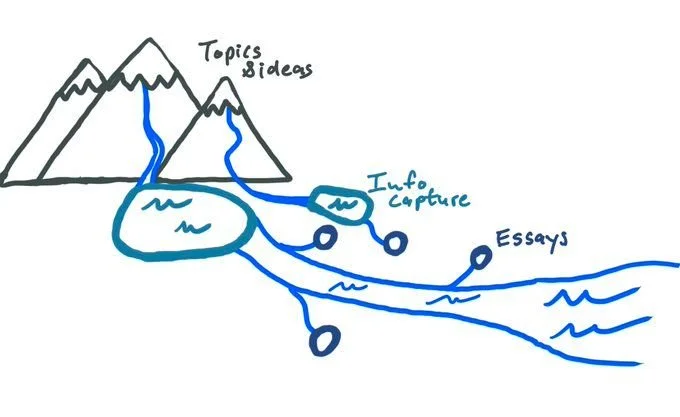Learning Nerd’s Diary #90
Welcome back Learning Nerds!
This week’s newsletter is a homage to the second careers that all LxDs have - writing!
I would be lying if I say that I don’t look like this at least a few times a week -
👀 Sneak peak
Here is what I have in store for you this week -
💭 Learning About Learning: The ‘Write’ Way to LxD
🥜 Learning Nugget: The Writing Chisel
💥 Coolest Thing I Learnt This Week:
Thoughts vs Writing
Printer Method vs Pixel Method
The Fisherman's Guide to Writing
🔦 Spotlight: Learning Out Loud!
Let's jump right in!
💭 Learning About Learning
What to design better learning experiences? Learn to write!
Anyone who designs learning experiences has to accept that writing is a core part of what we do. Just like a painter needs the right brush strokes, you need the right words.
But like different parts of a painting require different brushes, different parts of the design process require different kinds of writing.
In this article, we’ll explore 5 such parts of the LxD process -
🧑🏻🎨 Curriculum Design
Curriculum design is a pivotal point in the process. It's like sketching the outline of a painting before adding layers of colour.
Here, you need writing that's strategic and structured, mapping out what learners will encounter along their learning journey. Writing here almost acts as a north start - articulating the ‘what’ & ‘why’ before getting to the ‘how’ -
What writing looks like at this stage:
Course Outline: Clearly defined learning objectives and topics
Curriculum: Detailed descriptions of each module, the sequence & milestones
Assumptions: Prerequisites, learner profiles and other assumptions
🧑🏻🏫 Presentation
Live sessions are where a lot of the magic happens!
Writing here should be engaging, concise, and tailored to the purpose of the session & what is expected from it. Writing here often reinforces what the facilitator is saying.
What writing looks like at this stage:
Storytelling: Crafting compelling narratives, stories, scenarios and examples
Explanation: Helping learners understand specific concepts and topics
Instructions: Giving instructions for activities/ actions to be taken by learners during the session
📋 Communication
At various points in the learning journey, communication is critical! From expectation setting on the course to communicating the project that needs to be done.
Writing clearly and concisely becomes crucial. And writing here needs to balance between not saying enough and saying too much. Precision is key.
What writing looks like at this stage:
Instructions: Step-by-step guides for activities or experiments
Expectation Setting: Onboarding & giving an overview of what to expect from the course/ module/ session
Assessment & Feedback: Closing the loop on learning
📒 Documentation
Scaling learning design relies solely on documentation. And documenting SO many moving parts is hard.
Writing here should be meticulous and organised, capturing the essence of your design. Structure, templates and frameworks are key.
What writing looks like at this stage:
Design Manuals: Guidelines for replicating the learning experience
Experiment Log: Experiments run in the learning experience & their results
Data Analytics & Feedback: Summaries of learner performance and feedback.
✨ Evangelism
Whether we work inside L&D teams or work independently as course creators, all learning designers are evangelists.
Writing here needs to spark excitement and convince stakeholders, learners, or fellow designers of the value of your creation. It's akin to presenting your artwork in a gallery, highlighting its significance.
What writing looks like at this stage:
Proposals: Convincing stakeholders about the efficacy of your design.
Marketing Materials: Creating persuasive content to attract learners.
Blog Posts/Articles: Sharing success stories and insights from your design.
🌰 In a nutshell
Just as an artist's palette holds a variety of colors, a learning experience designer's toolkit must include diverse writing skills.
From the strategic strokes of curriculum design to the vibrant hues of presentation, the precision of instructions, the organisation of documentation, and the persuasive touch of evangelism, writing is key!
🥜 Learning Nuggets
Writing is a chisel for your thoughts.
Just as a sculptor carves stone into art, writing refines your ideas into knowledge. Shaping your understanding one word at a time.
💥 Coolest Thing I Learnt this Week
Thoughts & Writing
Printer vs Pixel Method
David Perell in this article, talks about two ways to write: The Printer Method and the Pixel Method.
The Printer Method is about chasing perfection while the Pixel Method is about believing in iteration. As David puts it -
Embrace the Pixel Method. Remember, even the best ideas are born blurry.
The Fisherman's Guide to Writing
John talks about his writing process in this article:
Good writing is downstream of good information capture, which is downstream of being aware of the topics and ideas that resonate with you.
Using the amazing anology of fishing the article offers a great start for any writing-curious’ folks!
🔦 Spotlight
📣 Learning Out Loud#1: Performance 📈, Desireable Difficulties 🧗🏻 & Balance ⚖️
A new series where I share things I am learning about! Any feedback/ comments are welcome :)
1/ Performance 📈
Demonstrating understanding or learning in a specific area. Think tests.
"One-time performance and long-term learning are not the same thing."
2/ Desireable Difficulty 🧗🏻
Problems that are intentionally incorporated into the learning process. Think interleaving, spaced repetition, retrieval practice & more.
"By making learners think deeper and work harder, we help them understand the material better and retain more information."
3/ Balance ⚖️
Designing the experience in a way that it reaches the optimum state of 'flow' for the learner
"Find the balance between challenge and attainability. When things are too difficult, learners may get discouraged. When things are too easy, they may grasp the material superficially."
Source:
This amazing article by Nidhi Sachdeva, PhD for 7taps Microlearning
Love & Learning
Until we meet next week!
You can get this directly in your inbox!









